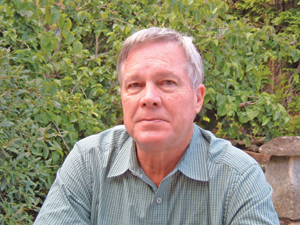Going Global
January 1, 2009
 Ever since 2000, John Hemphill has served as executive director of the North American Society for Trenchless Technology (NASTT) — helping to promote the industry in the United States, Canada and Mexico. Then in early 2008, Hemphill became the executive director of the International Society for Trenchless Technology (ISTT), setting his sights on a larger, global audience. In a one-on-one interview with Trenchless Technology, Hemphill discusses his transition to ISTT and his new role with the organization, as well as the international trenchless market and future goals for the industry.
Ever since 2000, John Hemphill has served as executive director of the North American Society for Trenchless Technology (NASTT) — helping to promote the industry in the United States, Canada and Mexico. Then in early 2008, Hemphill became the executive director of the International Society for Trenchless Technology (ISTT), setting his sights on a larger, global audience. In a one-on-one interview with Trenchless Technology, Hemphill discusses his transition to ISTT and his new role with the organization, as well as the international trenchless market and future goals for the industry.  1. Please briefly describe your professional background prior to joining NASTT. How did this help prepare you for the position?
1. Please briefly describe your professional background prior to joining NASTT. How did this help prepare you for the position?My professional career has included management positions in the fields of energy and engineering. I’ve had the opportunity to work closely with leaders in the business and public works community. Each job experience was both professionally rewarding and educational. And each of these experiences seemed to lead nicely into the next.
My work in engineering included time with the American Society of Civil Engineering (ASCE) where I got my first exposure to trenchless technologies. I later served as executive director of the Business Council for Sustainable Energy where I helped establish the group’s outreach program. These experiences served me well when I became the executive director of NASTT.
2. What about trenchless technology first attracted you to the field? What were your first impressions of the industry?
First, trenchless technology is new and it’s innovative. The market for trenchless applications is large relative to its share, so there are lots of opportunities for growth. It is hard not to be excited about a new and innovative industry with tremendous growth opportunities.
Second, the trenchless industry offers solutions for underground construction challenges, particularly in urban areas. Trenchless applications often are also the only viable solution for certain projects such as river, highway or railroad crossings. Properly used, trenchless can preserve the environment and can be the least-cost option.
3. Looking back at your tenure with NASTT, how did the industry evolve during that time? What would you consider the major accomplishments of the society during that time?
During my nearly 10 years with NASTT, there was a steady growth in the acceptance of trenchless technologies by the construction community — not meteoric, but steady. Today, more and more users are comfortable with trenchless solutions. As trenchless technologies gained in acceptance, NASTT shifted from basic trenchless technology education to in-depth training on specific trenchless applications.
Clearly, the major accomplishment of NASTT during my time with the Society was the development of technology-specific trenchless training modules. These modules address the most pressing educational needs of the industry and are extremely well regarded in the underground construction community.
4. How did your experience with NASTT help prepare you for your position with ISTT?
The ISTT and NASTT share the same mission and similar goals — furthering trenchless technologies for the benefit of the public. The focus of both organizations is also similar, if not identical — education and training. NASTT serves the North America region. ISTT is global. ISTT often works with its affiliate societies such as NASTT to fulfill its mission. However, the ISTT also reaches out to regions of the world where we have no affiliates to offer education and training programs.
5. How would you compare your time spent with NASTT to what you have experienced since joining ISTT?
I see many similarities. In addition to a common mission and similar goals, they both strive to deliver high-quality information on trenchless and to educate and inform the underground construction community of the opportunities for using trenchless solutions to minimize surface disruption and reduce costs.
Operationally, there are some differences. The geographic scope of the ISTT is broader. Our focus is to support our affiliated societies and to work with and through these societies to advance trenchless technology.
6. There is an increasing movement toward environmentally friendly or “green” construction techniques. How is this affecting the trenchless marketplace?
Trenchless often has a positive environmental edge over conventional underground construction methods. This fact is a plus for trenchless, but for the most part, I do not believe that will be the deciding factor in selection of a trenchless method over a conventional construction method — price almost always rules. But in environmentally sensitive areas, such as wetlands or river crossings, trenchless may be the only viable solution.
7. What regions of the world do you see as potential growth areas for trenchless technologies?
Growth opportunities for trenchless are identical to the growth opportunities for underground construction generally. These markets are expanding to include fast growing, developing countries with large urban populations. Often the underground infrastructure in these countries is in need of significant repair, replacement or expansion.
8. The global credit crisis is having a profound impact on the construction market. Is this an opportunity to promote trenchless? How so?
I believe the credit crisis may present an opportunity for trenchless because the use of trenchless often is superior to conventional methods from a cost standpoint. On balance, however, I do not believe that a continued tight credit market benefits anyone or any industry.
9. What other pressing needs are facing the international trenchless market today? What role will ISTT play in addressing these needs?
The ISTT shares the challenges of its affiliates. We need to continue to work to educate the underground construction community on trenchless applications. Trenchless technologies are less than 40 years old — a very short time in underground construction history. Acceptance of innovative solutions has often come slowly. Trenchless societies, including ISTT, must provide a forum for professionals to exchange information, and for experts with real-world experience in the use of trenchless technologies to educate and inform those who are new to these technologies about their many benefits.
10. What role do the regional chapters play in the operation of ISTT? How does this make the society unique? Are there plans to add chapters?
The ISTT has 21 affiliated societies, each serving the trenchless community in its region of the world. NASTT, for example, serves Canada, the United States and Mexico. Each affiliate answers to its own membership.
The ISTT provides a bridge for communication among affiliated societies. International No-Dig shows, co-hosted by ISTT and affiliated societies, are but one example. International venues offer opportunities for regional societies to come together, learn from each other and gauge the market for trenchless elsewhere in the world. The ISTT actively promotes new affiliated societies. Within the past year, Bulgaria has joined the ISTT and Ukraine is now in line for membership.
11. What do you hope to accomplish with ISTT in the near future? In the long term?
The ISTT has an ambitious program to expand its educational outreach program to parts of the world not covered by affiliated societies and to continue to add new programs that benefit our affiliated members. Developing technology-specific training courses is an important element of this program. We will begin to roll out new training courses in 2009. It will take several years to complete this effort.
12. Give us your thoughts on the upcoming International No-Dig in Toronto. Why was Toronto selected as a venue?
I am looking forward to the 2009 International No-Dig in Toronto. On a personal note, it will be my first NASTT-hosted event since I left NASTT. I look forward to seeing many old friends. From the perspective of executive director of ISTT, I am extremely excited about Toronto as a venue. Toronto is a world-class city that is an attractive destination for people from all over the world. Toronto and surrounding jurisdictions have been leaders in applying trenchless technologies.
Toronto was selected by the ISTT Board of Directors to host the 2009 International No-Dig based on the application submitted by NASTT. I was a member of the NASTT team that presented the application to the ISTT Board and I am proud to have been associated with that successful effort.
13. There are some changes in the works for future No-Digs — such as involving countries that do not have affiliated societies. How important are shows like No-Dig and Trenchless Middle East to the industry?
I have already said that the ISTT plans to expand its educational outreach program to regions not covered by affiliates. We are looking at venues where we see a need for trenchless education and training such as the Pacific-Rim, the Middle East, Africa and South America. We also have had success working with other organizations to hold trenchless training courses such as Trenchless Middle East.
In 2009 and 2010, we plan to pursue these types of opportunities. On Feb. 16-18, 2009, we will hold ISTT training courses in association with Trenchless Middle East. In the latter part of 2010, we intend to hold our International No-Dig in Singapore. The Singapore No-Dig will be our first No-Dig without the direct participation of an affiliated society.
Ryan Sweeney is an editorial assistant for Trenchless Technology.




